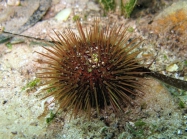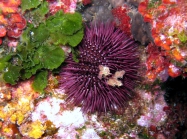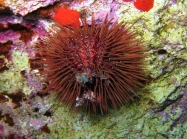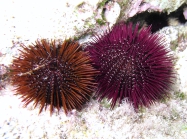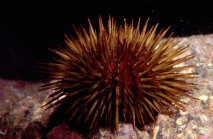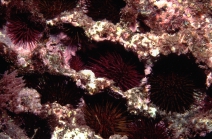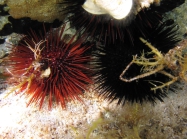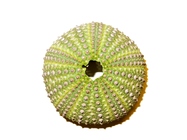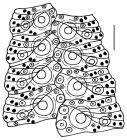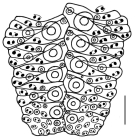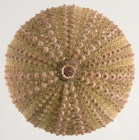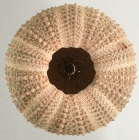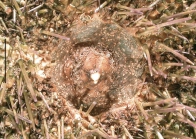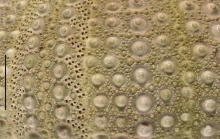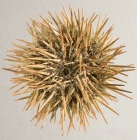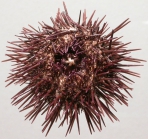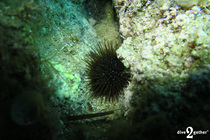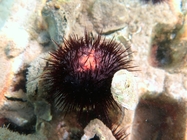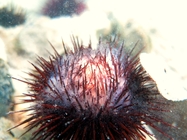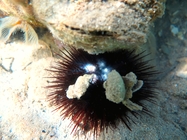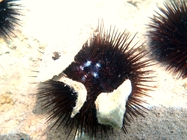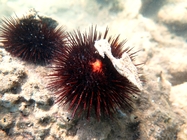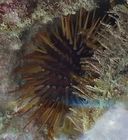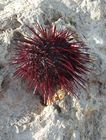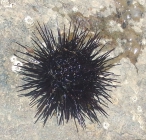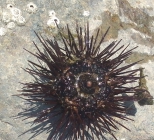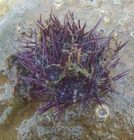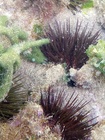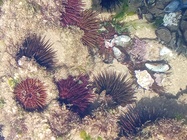
| Introduction | | Search taxa | | Taxon tree | | Taxon match | | Checklist | | Literature | | Stats | | Photogallery | | OBIS Vocab | | Log in |
WoRMS taxon detailsParacentrotus lividus (Lamarck, 1816)
124316 (urn:lsid:marinespecies.org:taxname:124316)
accepted
Species
Echinus (Toxopneustes) complanatus L. Agassiz & Desor, 1846 · unaccepted (subjective junior synonym)
Echinus (Toxopneustes) concavus L. Agassiz in L. Agassiz & Desor, 1846 · unaccepted (subjective junior synonym)
Echinus (Toxopneustes) lividus (Lamarck, 1816) · unaccepted (transferred to Paracentrotus)
Echinus lithophagus Leach in Tilloch, 1812 · unaccepted (nomen nudum)
Echinus lividus Lamarck, 1816 · unaccepted (transferred to Paracentrotus)
Echinus purpureus Risso, 1826 · unaccepted (subjective junior synonym)
Echinus vulgaris Blainville, 1825 · unaccepted (subjective junior synonym)
Euryechinus lividus (Lamarck, 1816) · unaccepted (transferred to Paracentrotus)
Microcordyla asteriae Zirpolo, 1927 · unaccepted (based on echinoid pedicellariae...)
based on echinoid pedicellariae misinterpreted as sponge Paracentrotus (Strongylocentrotus) lividus (Lamarck, 1816) · unaccepted (unaccepted combination)
Strongylocentrotus lividus (Lamarck, 1816) · unaccepted (transferred to Paracentrotus)
Toxocidaris livida (Lamarck, 1816) · unaccepted (transferred to Paracentrotus)
Toxopneustes complanatus L. Agassiz & Desor, 1846 · unaccepted (subjective junior synonym)
Toxopneustes concavus L. Agassiz in L. Agassiz & Desor, 1846 · unaccepted (subjective junior synonym)
Toxopneustes lividus (Lamarck, 1816) · unaccepted (transferred to Paracentrotus)
marine,
recent + fossil
(of Echinus (Toxopneustes) lividus (Lamarck, 1816)) Lamarck, [J.-B. M.] de. (1816). <i>Histoire naturelle des animaux sans vertèbres</i>, Tome troisième, 586 pp. Paris, Deterville/Verdière. , available online at http://www.biodiversitylibrary.org/item/47702
page(s): 50 [details]
Distribution In hollows in pools and crevices in the intertidal zone, also sublittoral to about 30 m depth, on stony ground and...
Distribution In hollows in pools and crevices in the intertidal zone, also sublittoral to about 30 m depth, on stony ground and burrowing in the lithothamnion gravel (maerl). Once common in western Ireland, from Cork to Donegal, now depleted by commercial harvesting; very rare in Devon, Cornwall and the Islec of Scilly, occaional in the Channel Islannds, rare in western Scotland, around Skye and the smaller islands nearby [details]
Kroh, A.; Mooi, R. (2025). World Echinoidea Database. Paracentrotus lividus (Lamarck, 1816). Accessed through: World Register of Marine Species at: https://www.marinespecies.org/aphia.php?p=taxdetails&id=124316 on 2025-07-16
Date action by
Nomenclatureoriginal description
(of Echinus purpureus Risso, 1826) Risso, A. (1826-1827). Histoire naturelle des principales productions de l'Europe Méridionale et particulièrement de celles des environs de Nice et des Alpes Maritimes. <em>[book series].</em> 400 pp., 13 pls. [volumes 1-5. Paris, F.G. Levrault. vol. 3. Mammifères. Oiseaux. Poissons / vol. 4. Mollusques. Annélides / vol. 5. Crustacés. Myriapodes, scorpionides, arachnides et acarides. Insectes. Vers intestinaux. Radiaires. Zoophytes]., available online at http://www.biodiversitylibrary.org/bibliography/58984 page(s): 277 [details] original description (of Echinus vulgaris Blainville, 1825) Blainville, H. M. D. d. 1825. Oursin, Echinus (Actinozoaires.). Pp. 59-98 in Dictionnaire des Sciences Naturelles F.G. Levrault, Strasbourg & Paris., available online at https://www.biodiversitylibrary.org/page/25303522 page(s): 86 [details] original description (of Microcordyla asteriae Zirpolo, 1927) Zirpolo, G. 1927 [1926]. Di una nuova Silicospugna del Golfo di Napoli (<i>Microcordyla asteriae</i> n.g. n.sp.). Bolletino della Società dei Naturalisti in Napoli (2) 38(18): 287-290. [details] original description (of Echinus (Toxopneustes) lividus (Lamarck, 1816)) Lamarck, [J.-B. M.] de. (1816). <i>Histoire naturelle des animaux sans vertèbres</i>, Tome troisième, 586 pp. Paris, Deterville/Verdière. , available online at http://www.biodiversitylibrary.org/item/47702 page(s): 50 [details] original description (of Echinus lithophagus Leach in Tilloch, 1812) Leach, W. E. 1812. [Echinus lithophagus]. Pp. 130-152 in Tilloch, A. (ed.) XXI. Proceedings of Learned Societies. The Philosophical Magazine: comprehending the various branches of science, the liberal and fine arts, agriculture, manufactures and commerce 39, 130-152., available online at http://www.archive.org/stream/lepidopterarepor39winc#page/151/mode/2up page(s): 151 [details] original description (of Echinus (Toxopneustes) complanatus L. Agassiz & Desor, 1846) Agassiz, L. & Desor, P. J. E. 1846. Catalogue raisonné des familles, des genres, et des espèces de la classe des échinodermes. Annales des Sciences Naturelles, Troisième Série, Zoologie 6, 305-374., available online at https://www.biodiversitylibrary.org/page/13408315 page(s): 367 [details] original description (of Echinus (Toxopneustes) concavus L. Agassiz in L. Agassiz & Desor, 1846) Agassiz, L. & Desor, P. J. E. 1846. Catalogue raisonné des familles, des genres, et des espèces de la classe des échinodermes. Annales des Sciences Naturelles, Troisième Série, Zoologie 6, 305-374., available online at https://www.biodiversitylibrary.org/page/13408315 page(s): 367 [details] basis of record Hansson, H.G. (2001). Echinodermata, <B><I>in</I></B>: Costello, M.J. <i>et al.</i> (Ed.) (2001). <i>European register of marine species: a check-list of the marine species in Europe and a bibliography of guides to their identification. Collection Patrimoines Naturels,</i>. 50: pp. 336-351. (look up in IMIS) [details] Otheradditional source
Mortensen, T. (1943). A Monograph of the Echinoidea. III, 3. Camarodonta. II. Echinidæ, Strongylocentrotidæ, Parasaleniidæ, Echinometridæ. 446 pp., C. A. Reitzel, Copenhagen.
page(s): 157-168 [details] additional source Southward, E.C.; Campbell, A.C. (2006). [Echinoderms: keys and notes for the identification of British species]. <i>Synopses of the British fauna (new series)</i>, 56. Field Studies Council: Shrewsbury, UK. ISBN 1-85153-269-2. 272 pp. (look up in IMIS) [details] additional source Hayward, P.J. & J.S. Ryland (Eds.). (1990). The marine fauna of the British Isles and North-West Europe: 1. Introduction and protozoans to arthropods. <em>Clarendon Press: Oxford, UK.</em> 627 pp. (look up in IMIS) [details] Available for editors  Present Present  Present in aphia/obis/gbif/idigbio Present in aphia/obis/gbif/idigbio  Inaccurate Inaccurate  Introduced: alien Introduced: alien  Containing type locality Containing type locality
From editor or global species database
Distribution In hollows in pools and crevices in the intertidal zone, also sublittoral to about 30 m depth, on stony ground and burrowing in the lithothamnion gravel (maerl). Once common in western Ireland, from Cork to Donegal, now depleted by commercial harvesting; very rare in Devon, Cornwall and the Islec of Scilly, occaional in the Channel Islannds, rare in western Scotland, around Skye and the smaller islands nearby [details]IUCN Red List Category Barcelona Convention Annex III (Species whose exploitation is regulated) [details] Unreviewed
Breeding Echinopluteus larva. Summer [details]
Encyclopedia of Marine Life of Britain and Ireland
Marine Life Information Network - UK To Barcode of Life (251 barcodes) To Biodiversity Heritage Library (151 publications) (from synonym Toxopneustes lividus (Lamarck, 1816)) To Biodiversity Heritage Library (153 publications) To Biodiversity Heritage Library (223 publications) (from synonym Echinus lividus Lamarck, 1816) To Biodiversity Heritage Library (25 publications) (from synonym Echinus vulgaris Blainville, 1825) To Biodiversity Heritage Library (26 publications) (from synonym Echinus purpureus Risso, 1826) To Biodiversity Heritage Library (356 publications) (from synonym Strongylocentrotus lividus (Lamarck, 1816)) To European Nucleotide Archive, ENA (Paracentrotus lividus) To Fishipedia To GenBank (161914 nucleotides; 1662 proteins) To Global Biotic Interactions (GloBI) To MNHN Fossil collection (Paracentrotus lividus (LAMARCK, 1816); Figuré; F.J06088) To PESI (from synonym Echinus vulgaris Blainville, 1825) To PESI (from synonym Echinus purpureus Risso, 1826) To PESI (from synonym Echinus lividus Lamarck, 1816) To PESI To USNM Invertebrate Zoology Echinodermata Collection (99 records) To Yale Peabody Museum of Natural History (YPM IZ 093890) To ITIS |


